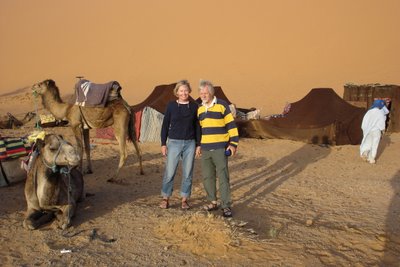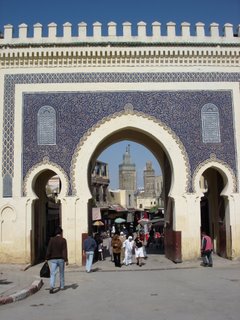Morocco
 Morocco
MoroccoOur trip to Morocco features high on April’s memorable times. It was the perfect place to take Chinook out of the EU for a short period to avoid paying VAT on her, and the bonus was seeing such a different land and culture than we had ever seen before. Right out of National Geographic!
The 25 nm sail across from Gibraltar was a slow (average 3 knots) due to an adverse current encountered half way across the Strait and light winds. Marina Smir on the north coast is run on Spanish lines and is very efficient in terms of checking in and berthing and not crowded, although miles from anywhere. Relatively expensive for Moroccan harbours (mostly fishing harbours – there are very few actual marinas in Morocco), it is noted for its good security and for our trip inland to see more of the country; that was paramount for us.
 In the Medina (ancient walled city) in Tetouan
In the Medina (ancient walled city) in TetouanA few days exploring the nearby towns; a 10 K bike ride to M’diq, and a half-hour 10 Dirham (one euro) public taxi ride to Tetouan which has an ancient walled city (the medina). Public taxis are ageing (probably formerly condemned) Mercedes Benzes which ply the roads always seeming to eventually pick up and cram in six passengers. We started to sand the butterfly hatch in preparation for re-varnishing, then the rain halted that so we decided to head inland to the holy city of Fez (a UNESCO World Heritage Site) and further south to the great Sahara.
It was a fabulous six days; a total of about 2000 Km, four long days of bus travel and two days and nights in the desert trekking on camels to an oasis and sleeping in nomad tents. The bus ride through the Rif and Atlas Mountain ranges presented us with such a varied vista of landscapes. From the beaches on the coast, through fertile mountain valleys, pine cedar and eucalyptus forests to starkly barren (still snow-capped) mountains and finally to the flat orange-brown desert plains. The road winds along the Ziz valley – oasis like with date palms, olive groves and herded flocks of goats and sheep.
 Photo: A village in the dry Atlas Mountains Houses made of clay blocks.
Photo: A village in the dry Atlas Mountains Houses made of clay blocks.Morocco is a third world country most of the population living below the poverty level - on less than a dollar a day. People are, however, very friendly, genuinely wanting to help and practice their English on us. Often we were approached by beggars but they were never as “pushy” as the people who wanted to guide us. French is very widely spoken (thank goodness for Debby’s French language skills) along with some Spanish. The thousands-of-years of history of the country is tremendously interesting. Islam is the principal religion; loudspeakers call the faithful Muslims to prayer four times a day from minarets to the local mosque (or the prayer room in the bus stations - our desert guides prayed at four a.m. outside our tent). Women of course cover most of their skin (but few had complete face covering and many of the younger set in the larger cities dressed western style), Deborah certainly was looked up and down by everyone even though she did wear long sleeves and jeans for a disguise – her blonde hair and blue eyes were a bit of a giveaway.
 The Blue Gate in the Medina (old city) in Fez. Fantastic tile mosaics.
The Blue Gate in the Medina (old city) in Fez. Fantastic tile mosaics. Just have to mention food before making this into a complete travelogue: we ate traditional meals of (uninspiring) lamb stew and couscous (tajine), a delicious beef dish baked in a clay pot with peppers, onions and tomatoes (almost swimming in olive oil and Moroccan spices - Brian’s attempt to copy it on Chinook did not do it justice), barbecued lamb at roadside stands, deep-fried chickpea fritters, chicken samosa-like pastilles, fresh sheep cheese, many, many flat bread “rounds”, sweet mint tea, and Deborah found plenty of pastries to satisfy her sweet tooth. Fresh eggs, fruits and veges are cheap and plentiful in the markets, but the hanging meat joints with their fly crowds did not appeal to us . The Moroccan beer (Flag) is “run-of-the-mill” and the wine, a shiraz-cabernet, is inexpensive and good. Islam prohibits alcohol, so alcohol is not easy to find and there are few drinking establishments. It was a dry six days in the desert (literally).
.
.
 Photo: the tannery in Fez. Very very smelly. We put crushed mint leaves up our nostrils to help combat the stink.
Photo: the tannery in Fez. Very very smelly. We put crushed mint leaves up our nostrils to help combat the stink.It may bore you to go on further. We have many more tales to tell, but we won’t bog you down with all the details. Seeing artisans working with copper, brass, silver, wood, leather, silk, ceramics, watching carpets being hand woven, hides being tanned, tiles being painted … The sights, sounds, smells and tastes of the cities, people, architecture, landscapes, and food kept us amazed for the time we spent in Morocco. If you ever get the chance, we thoroughly recommend the Moroccan experience.
Hand weaving a carpet. It takes 25 days to do one square metre
 Presently we are sailing east, coast-hopping along the Spanish Costa del Sol to the Balearic Islands where we will spend the summer months. Depending on the weather this is a 300 nm trip of a couple of weeks. Catching up with other cruising couples we have met (who are also heading in that direction) will be fun.
Presently we are sailing east, coast-hopping along the Spanish Costa del Sol to the Balearic Islands where we will spend the summer months. Depending on the weather this is a 300 nm trip of a couple of weeks. Catching up with other cruising couples we have met (who are also heading in that direction) will be fun.The camel train winding thru the Chebbi Dunes to the oasis (or: Debbi in the Chebbi)
 Remember you can enlarge the photos by clicking on them, but choose "BACK" to go back to this page.
Remember you can enlarge the photos by clicking on them, but choose "BACK" to go back to this page.Click here to return to the HOME PAGE
